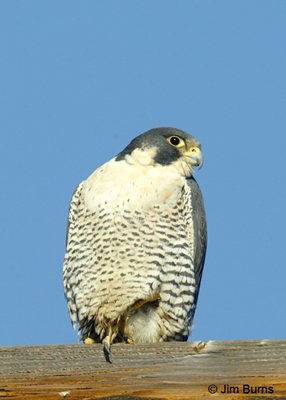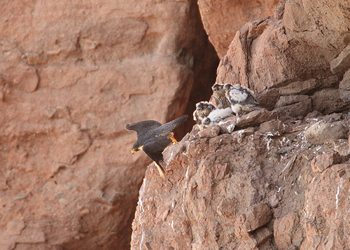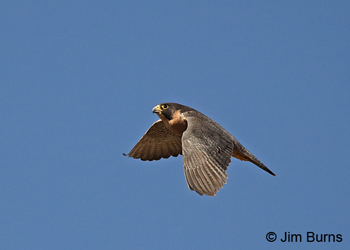
Given a moment to calm down and realize what we were hearing, Deva and I glanced at one another and began to smile. It was November, 1998, later in the same year that Arizona Game & Fish Department (AZGFD ) also had become aware of the Peregrine Falcons nesting on the east face of Camelback Mountain in Phoenix. The recent article in Birdwatching (October 2016) celebrating Chicago’s thriving Peregrine population—over a dozen nesting sites and over 500 chicks banded--prompted me to get in touch with Bill Burger of AZGFD for an update on the Phoenix Peregrine population and some comparison to the Chicago Peregrine Program’s success.
After the Peregrine was placed on the Endangered Species List in 1970 and DDT was banned in 1972, the recovery of the planet’s fastest bird was most auspiciously highlighted when and where breeding pairs began nesting on and amidst urban skyscrapers in the north and east. It was initially assumed that the climate of Phoenix, often and aptly described as a “heat island,” would not accommodate this urbanization of an avian species synonymous with wilderness. Though certainly not in numbers anything like Chicago’s, there are now Peregrine Falcons in Phoenix year round, two known nesting sites in Phoenix metro, and another just outside the metro area on the Tonto National Forest.
In addition to the Camelback Mountain location, Peregrines have been nesting on the Maricopa County Administration Building downtown since 2006. Though this site is not accessible to the public, you can check out the webcam using the following link. https://www.azgfd.com/wildlife/viewing/webcamlist/peregrine/peregrinecam/ which is inactive now until nesting resumes at the site in early spring. In both of the past two breeding seasons this pair produced four eggs. Two young were fledged in 2015, but this year unfortunately none survived. In a conversation with the Camelback aerie monitor who began her observations in 2002, she related that three chicks fledged from the aerie there in both 2015 and 2016, and the average since she began has been three/year with as many as four a couple times.
We saw our first Arizona Peregrine in the winter of 1981 high atop the Arizona Bank Building at First Avenue and Monroe in Phoenix, presumably before there were any nesting attempts here, but obviously after Peregrines discovered two important amenities of downtown urban living here in the desert: faux cliffs (skyscrapers) from which to stoop on prey, and plenty of that prey (pigeons and doves). Good places in the Phoenix metro to observe Peregrines, especially in cold weather months which bring an influx from the north, some migrating through, others overwintering, are the Gilbert Riparian Area, the Glendale Recharge Basins, the agricultural fields in the far west Valley, and the sod farms just east of the 101 in east Scottsdale. Watch for Peregrines anywhere there are high observation posts overlooking wide open spaces which attract many small passerines and/or shorebirds. These are open air groceries for Peregrines.
When we conceived the idea of our website, we decided we would display only a few of the best images for each species, but I’ve found I cannot not take photos of Peregrines. Our website now hosts thirty-three Peregrine images http://jimburnsphotos.com/pages/peregrinefalcon.html, and I make no apologies for this, even for some of the images not up to my usual photographic standards. We have Peregrines in flight, on aeries, plucking prey, exchanging prey, feeding young, flying through swarms of bees, and displaying the tomial tooth on a beak covered with blood.
My goal in life is to photograph a Peregrine bathing and Peregrines copulating. I don’t know if they bathe, but other raptors do. I know they copulate, though I’ve never seen a photo. The opening photo is an old one, my first good photo of the falcon, taken on the Samish Flats in Washington state. The closing photos are Phoenix birds, the Camelback aerie on the left, the female from the Tonto pair on the right. The latter was taken last week, and yes, it is on the website now, #34.
Peregrine Falcons, because of their beauty, their speed aflight, and their legendary reputation in the history of falconry and the mythology of our own species, occupy a special niche in our environment and in our collective psyche. Their “wildness” is unmitigated by their recent adaptation to proximity with us in our urban warrens. We can never get enough “Peregrine.” We can’t imagine there could ever be too many Peregrines. This image, this idea, this ideal of the fleet and regal wandering avian hunter is buried deep within the human DNA, accompaniment for our species before our species’ knuckles left the ground.
Chuck Hagner, the editor of Birdwatching, in his introduction to the Chicago Peregrines article, said it all—The Endangered Species Act works! Celebrate the comeback of the Peregrines. Check out their page on our website. Get out there and start looking.
|
Peregrine Falcon female in flight |

